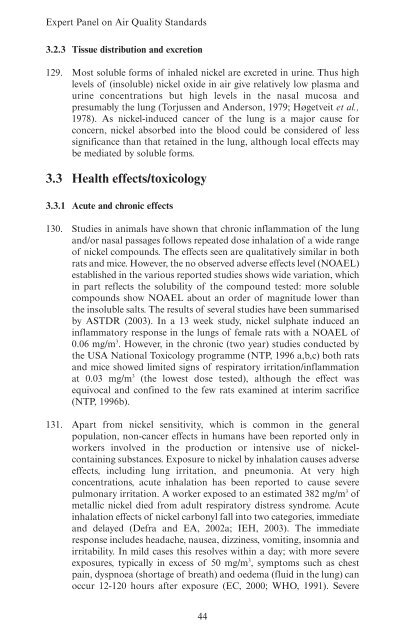Guidelines for Metals and Metalloids in Ambient ... - ARCHIVE: Defra
Guidelines for Metals and Metalloids in Ambient ... - ARCHIVE: Defra
Guidelines for Metals and Metalloids in Ambient ... - ARCHIVE: Defra
You also want an ePaper? Increase the reach of your titles
YUMPU automatically turns print PDFs into web optimized ePapers that Google loves.
Expert Panel on Air Quality St<strong>and</strong>ards<br />
3.2.3 Tissue distribution <strong>and</strong> excretion<br />
129. Most soluble <strong>for</strong>ms of <strong>in</strong>haled nickel are excreted <strong>in</strong> ur<strong>in</strong>e. Thus high<br />
levels of (<strong>in</strong>soluble) nickel oxide <strong>in</strong> air give relatively low plasma <strong>and</strong><br />
ur<strong>in</strong>e concentrations but high levels <strong>in</strong> the nasal mucosa <strong>and</strong><br />
presumably the lung (Torjussen <strong>and</strong> Anderson, 1979; Høgetveit et al.,<br />
1978). As nickel-<strong>in</strong>duced cancer of the lung is a major cause <strong>for</strong><br />
concern, nickel absorbed <strong>in</strong>to the blood could be considered of less<br />
significance than that reta<strong>in</strong>ed <strong>in</strong> the lung, although local effects may<br />
be mediated by soluble <strong>for</strong>ms.<br />
3.3 Health effects/toxicology<br />
3.3.1 Acute <strong>and</strong> chronic effects<br />
130. Studies <strong>in</strong> animals have shown that chronic <strong>in</strong>flammation of the lung<br />
<strong>and</strong>/or nasal passages follows repeated dose <strong>in</strong>halation of a wide range<br />
of nickel compounds. The effects seen are qualitatively similar <strong>in</strong> both<br />
rats <strong>and</strong> mice. However, the no observed adverse effects level (NOAEL)<br />
established <strong>in</strong> the various reported studies shows wide variation, which<br />
<strong>in</strong> part reflects the solubility of the compound tested: more soluble<br />
compounds show NOAEL about an order of magnitude lower than<br />
the <strong>in</strong>soluble salts. The results of several studies have been summarised<br />
by ASTDR (2003). In a 13 week study, nickel sulphate <strong>in</strong>duced an<br />
<strong>in</strong>flammatory response <strong>in</strong> the lungs of female rats with a NOAEL of<br />
0.06 mg/m 3 . However, <strong>in</strong> the chronic (two year) studies conducted by<br />
the USA National Toxicology programme (NTP, 1996 a,b,c) both rats<br />
<strong>and</strong> mice showed limited signs of respiratory irritation/<strong>in</strong>flammation<br />
at 0.03 mg/m 3 (the lowest dose tested), although the effect was<br />
equivocal <strong>and</strong> conf<strong>in</strong>ed to the few rats exam<strong>in</strong>ed at <strong>in</strong>terim sacrifice<br />
(NTP, 1996b).<br />
131. Apart from nickel sensitivity, which is common <strong>in</strong> the general<br />
population, non-cancer effects <strong>in</strong> humans have been reported only <strong>in</strong><br />
workers <strong>in</strong>volved <strong>in</strong> the production or <strong>in</strong>tensive use of nickelconta<strong>in</strong><strong>in</strong>g<br />
substances. Exposure to nickel by <strong>in</strong>halation causes adverse<br />
effects, <strong>in</strong>clud<strong>in</strong>g lung irritation, <strong>and</strong> pneumonia. At very high<br />
concentrations, acute <strong>in</strong>halation has been reported to cause severe<br />
pulmonary irritation. A worker exposed to an estimated 382 mg/m 3 of<br />
metallic nickel died from adult respiratory distress syndrome. Acute<br />
<strong>in</strong>halation effects of nickel carbonyl fall <strong>in</strong>to two categories, immediate<br />
<strong>and</strong> delayed (<strong>Defra</strong> <strong>and</strong> EA, 2002a; IEH, 2003). The immediate<br />
response <strong>in</strong>cludes headache, nausea, dizz<strong>in</strong>ess, vomit<strong>in</strong>g, <strong>in</strong>somnia <strong>and</strong><br />
irritability. In mild cases this resolves with<strong>in</strong> a day; with more severe<br />
exposures, typically <strong>in</strong> excess of 50 mg/m 3 , symptoms such as chest<br />
pa<strong>in</strong>, dyspnoea (shortage of breath) <strong>and</strong> oedema (fluid <strong>in</strong> the lung) can<br />
occur 12-120 hours after exposure (EC, 2000; WHO, 1991). Severe<br />
44
















